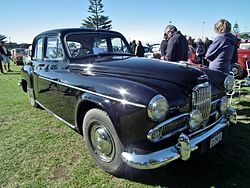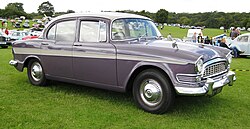Humber Super Snipe
| Humber Super Snipe | |
|---|---|
| Production period: | 1938-1940 1945-1967 |
| Class : | upper middle class |
| Body versions : | Limousine , Pullman limousine , station wagon , convertible |
| Previous model: | Humber Snipe |
The Humber Super Snipe is an upper mid-range passenger car manufactured by the Rootes Group and sold under their Humber brand .
1938 model
| 1938 model | |
|---|---|
|
Humber Super Snipe Sedan (1939) |
|
| Production period: | 1938-1940 |
| Body versions : | Limousine , cabriolet |
| Engines: |
Otto engine : 4.1 liters (74 kW) |
| Length: | 4445 mm |
| Width: | 1778 mm |
| Height: | |
| Wheelbase : | 2896 mm |
| Empty weight : | |
The first Super Snipe was introduced as the successor to the Snipe in October 1938 and was created by combining the 4.0 liter six-cylinder in-line engine from the larger Humber Pullman with the chassis and body of the Humber Snipe, a 3.0 liter car. Machine, combined. The result was a higher performing car that was considered very fast at the time.
The Super Snipe was primarily intended for managers, business people, and senior government officials and officials. For its size and performance, it was relatively inexpensive, similar in appearance and concept to the American car, and also quite inexpensive.
World War II broke out a year after the model was introduced , but the car continued to be produced for the military. The chassis was also used for the armored "light reconnaissance vehicle" Humber LRC . Around 1500 copies of the Super Snipe were made by 1940.
Mark I-III
| Mark I-III | |
|---|---|
|
Humber Super Snipe Mark III Sedan (1951) |
|
| Production period: | 1945–1952 |
| Body versions : | Sedan , station wagon , convertible |
| Engines: |
Otto engine : 4.1 liters (74 kW) |
| Length: | 4572-4851 mm |
| Width: | 1753-1880 mm |
| Height: | |
| Wheelbase : | 2896-2972 mm |
| Empty weight : | |
In 1945 peace production was resumed. Several evolutionary stages, Mark I – III , have been developed from the Super Snipe , each larger, stronger and more modern than the previous one.
After the war, the Rootes Group also started exporting the vehicle. The Super Snipe was very popular in Australia .
Mark I.
The model launched in 1945 was essentially a revised pre-war model. The length had grown to 4572 mm, the engine was with 4.1 liter displacement and 100 bhp output at 3400 / min. stayed the same. 3909 copies were produced by 1947.
Mark II
In 1948 the Super Snipe got a completely new body with a length of 4750 mm and width of 1880 mm. The headlights were integrated into the front fenders and there were running boards again. The wheels were still individually suspended from transverse leaf springs. In 1949 and 1950, some Tickford cars were bodied as convertibles. Early examples of the Mark II can be recognized by the round lamps below the headlights. The left was a fog lamp, the right was used to illuminate the road when overtaking. From 1949, there were rectangular additional lights instead. By 1949 8361 Super Snipe Mark II were built.
Mark III
The outside of the Mark III appeared almost unchanged in 1950, but was another 100 mm longer at 4851 & mm. A Panhard rod was also installed on the rear axle , which limited the lateral movements of the rear wheels and enabled the installation of softer springs. Simpler bumpers and stainless steel pads on the running boards make it easy to distinguish from the Mark II. 8703 copies were made by 1952.
Mark IV
| Mark IV | |
|---|---|
|
Humber Super Snipe Mark IV (1955) |
|
| Production period: | 1952-1958 |
| Body versions : | limousine |
| Engines: |
Petrol engines : 4.1 liters (83-92 kW) |
| Length: | 4572-4851 mm |
| Width: | 1753-1880 mm |
| Height: | 1400 mm |
| Wheelbase : | 2896-2972 mm |
| Empty weight : | |
In 1952 the Mark IV replaced the Mark III. The car with the modern, elongated pontoon body of the Hawk Mark IV was now significantly longer, over 5 meters. The engine capacity had grown from 4086 cm³ to 4139 cm³ and the power increased to 113 bhp (83 kW). Later the power increased again to 122 bhp (90 kW). Station wagon and convertible were omitted; there was only the limo left. Among other things, it was also built on a new assembly line in Australia.
From 1956 a Borg-Warner 35 automatic transmission was also installed on request , but shortly afterwards production was stopped after 17,993 units.
Series I – V
| Series I – V | |
|---|---|
|
Humber Super Snipe Series II (1959) |
|
| Production period: | 1958-1967 |
| Body versions : | Limousine , Pullman limousine , station wagon |
| Engines: |
Petrol engines : 2.65–3.0 liters (77–95.8 kW) |
| Length: | 4699-4775 mm |
| Width: | 1765 mm |
| Height: | 1575 mm |
| Wheelbase : | 2794 mm |
| Empty weight : | |
In October 1958 a new Super Snipe was introduced, which was again based on the self-supporting body of the 4-cylinder Humber Hawk this time and was equipped with a 2.6 liter (later 3.0 liter) in-line six-cylinder engine from Armstrong-Siddeley . The 3.0-liter also had disc brakes up front.
The new Super Snipe was smaller on the outside but larger on the inside, had higher engine power and a more modern appearance, similar to that of the General Motors cars in the mid-1950s. He, too, was built in different stages of evolution, Series I and Series V . When Chrysler took over the Rootes Group, its production was finally stopped in July 1967.
Series I.
The new Super Snipe was equipped with a three-speed transmission. An overdrive could be activated in the upper gears . On request there was an automatic transmission from Borg-Warner and power steering . In addition to the limousine, a Pullman limousine was also offered. In the only year of production, 1958, 6072 copies were made.
Series II
The Series II appeared as early as 1959 with the engine bored out to 2965 cm³ and front disc brakes. There were no changes to the body. In the only year of production 7175 Super Snipe Series II were built.
Series III
Series III from 1960 had a new front with four headlights and a new radiator grille that stretched across the entire width of the vehicle. The length of the body had grown to 4775 mm. The extra length largely benefited the engine compartment. An additional belt pulley was attached to the front of the crankshaft to drive the new air conditioning system , which was urgently needed for the US market. 7,257 cars of this type had been built up to 1961, just a little more than in a single year.
Series IV
In 1962 the Series IV was presented with a few changes to the body and an engine that had been boosted to 124.5 bhp (94.5 kW). The panoramic rear window of the earlier models had given way to a pane trimmed at the corners. The rear doors had triangular windows that could be opened. By 1963, 6,495 Series IV cars had been built.
Series V
In 1964 the last series of the Super Snipe appeared. The structure was a little flatter, the rear window lower and the windshield a little larger. The station wagon remained unchanged. New carburetors and a revised cylinder head ensured a further increase in engine performance, which now delivered 128.5 bhp (95.8 kW). In July 1967 the series was discontinued after 3,032 copies. Only in Australia, at the Chrysler plant in Port Melbourne , were a few cars of this type produced until 1970.
Web links
- Site of the Humber Enthusiasts Group of New South Wales with many scanned sales brochures ( Memento of February 2, 2004 in the Internet Archive )
- More brochures (English) .
- Humberonia (English) ( Memento of 23 May 2008 at the Internet Archive ).
- Photos ( memento of April 15, 2012 in the Internet Archive ) and report (English) about the restoration of a Humber Super Snipe Series III
- Motorbase site via Humber
Individual evidence
- ↑ a b c David Culshaw & Peter Horrobin: Complete Catalog of British Cars . Macmillan, London 1974. ISBN 0-333-16689-2
- ↑ M. Sedgwick & M. Gillies: AZ of Cars of the 1930s . Bay View Books, Devon 1969. ISBN 1-870979-38-9
- ↑ a b c d e f g h i j M. Sedgwick & M. Gillies: A – Z of Cars 1945–1970 . Bay View Books, Devon 1969. ISBN 1-870979-39-7
- ↑ a b c Humber Super Snipe Saloon (road test) in Autocar . August 25, 1950
- ^ Second hand car guide supplement in Practical Motorist . No. 6 Nbr April 68, 1960. between p. 768 and p. 769
- ↑ Pedr Davis: The Macquarie Dictionary of Motoring . 1986. p. 226
- ↑ a b c The Humber Super Snipe in The Motor . February 10, 1960













